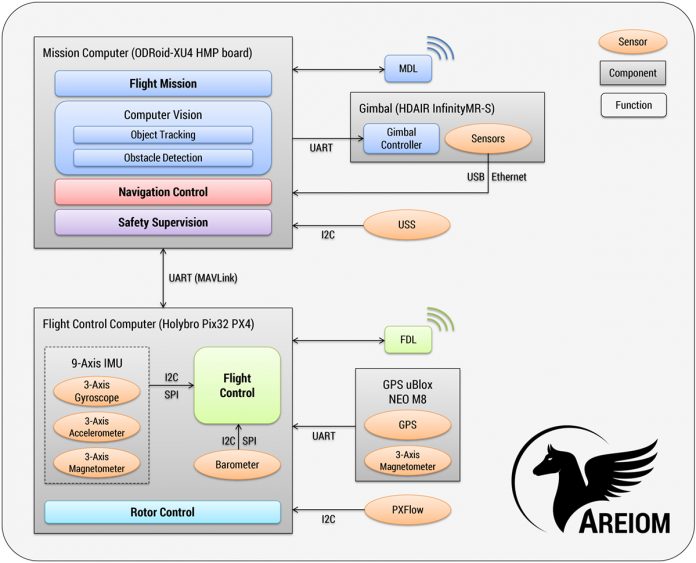Wolfram Hardt, Professor at Chemnitz University of Technology gives insight into their ongoing adaptive mission research for unmanned micro air vehicles (MAV)
Unmanned micro air vehicles (MAV) have spread widely in use during the last few years. Pilots control their MAV by remote control and video streams. The market for technical entertainment offers various MAV platforms equipped with sensors and cameras. For the main part, but the total weight of 2.5kg is not reached due to both handling and licensing reasons.
However, the tremendous number of applications, as well as the fascination of both pilots and users indicate a new upcoming field for professional applications for unmanned micro air vehicles (MAV). In our view, professional MAV technology offers additional resources in terms of energy capacity, standard sensors, as well as special sensors, multi-cameras and computation capacity. This increases the total weight up to 20 kg. High sophisticated flight control algorithms ensure comfortable flight characteristics and additional controllers stabilise both the central gimbal carrying cameras and special sensors.
Recent developments focus on all technical aspects and flight support functions. So, piloting becomes easy. The market for technical entertainment also offers the first autonomous MAV functions. Simple algorithms implement autonomous functions, e.g. return-to-home, follow-me as well as height limits, distance limits and recognition of NoFlyZones. Ideas for complex autonomous missions such as package-delivery in urban environments are still the subject of research and first prototypes for such evaluations are coming up.
The computer engineering group at Chemnitz University of Technology has been doing research on efficient hardware/software control applications since 2003. Results point out that the design of efficient systems optimises the computing architecture, with respect to the application. This is especially true for high-performance applications such as autonomous MAV missions, whereby the computing architecture must be composed with respect to this kind of application.
The challenge is, to design a computation platform that provides sufficient computation power, e.g. for real-time online image processing within the tight restrictions of both power consumption and total weight. For this reason, we developed the adaptive research platform AREIOM. The AREIOM platform defines five separate architecture levels for specific MAV tasks, especially three control levels for handling the rotors, the fight parameters and the navigation functions are distinguished. Additional architecture levels are introduced for safety supervision and the flight mission. Sensors and gimbal can be connected by standard interfaces.
In addition, previous discussed standard functions are implemented on the named control layers. The newly introduced flight mission layer offers computation resources for adaptable flight missions. Based on adaptability, autonomous missions for applications of limited complexity are implemented successfully. In this respect, applications in view are object inspections with optical and thermal cameras, industrial inspections, such as power lines and high voltage isolators.
Also, railway inspections, control of huge aerials such as marshalling yards and private house security tasks can be implemented with adaptive MAV technology. Such applications find an exponentially growing market in urban regions, if autonomous mission execution can be provided.
Based on our AREIOM platform, the concept of adaptive MAV mission has been developed and provides:
• Flexibility:
Adaptive MAV are not bound in their movements to a predefined infrastructure, such as streets or railways. Thus, MAV can be utilised independently of the costly infrastructure of urban environments. This reduces mission costs enormously.
• Agility:
MAV are highly agile vehicles with the ability to operate within a small area. MAV flight control and navigation control ensure agility, within an accuracy of just a few centimetres. Vertical take-off and land, turn-on-the-spot, fly-over and fly-under hindrances are examples of the agile abilities of MAVs. In urban environments, small area scenarios are typical and with adaptive MAVs and such locations can be both accessed and inspected.
• Adaptivity:
The ability to operate within a small area is imperative for professional MAV applications in urban environments today. Adaptive methods offer the necessary functions. In our research, we develop such adaptive methods, working in two phases.
In phase one, complex sensing is done to capture all information about the surrounding areas that the MAV is operating in. This includes hindrances, determination of inspection objects as well as detection of moving elements, e.g. vehicles, persons and animals. In this phase, we apply high-performance image processing. Image data is taken from a separate camera. Image processing includes pre-processing, object detection and objects recognition. This image processing phase can be accelerated by usage of FPGA technology for analysis of up to 700 fps. Image processing results in the determination of the so-called facts. For example, “inspection object found” can be such a fact. All facts are defined with respect to the application in view, so by this we describe the changes in the actual scenario.
In phase two, we calculate the facts of the next flight and navigation command of the mission. This calculation is also of a high complexity and must be executed in real-time. Different algorithms can be chosen. Artificial intelligence methods are well suited for this problem. Machine learning approaches require knowledge from characteristic examples to learn from. Such data can be collected by manual test missions if the mission application is predefined. Other approaches are expert system based. In this case, all possible decisions are summarised in decision graphs with can be traversed. Different technics for acceleration can be applied to meet the real-time requirements. We evaluated the well-known RETE-algorithm and introduced some optimisations. This leads to real-time responsiveness and reliable adaptive flight missions.
The AREIOM-Two-Phase calculation of adaptable missions could be implemented successfully on the AREIOM-platform. This new approach of adaptable MAV boosts the application of this technology in urban environments and opens new markets rapidly growing.
Please note: this is a commercial profile
Prof. Dr. Wolfram Hardt
Stephan Blockzyl, Dipl. Inf.

Chemnitz University of Technology
Tel: +49 371 531 25550











